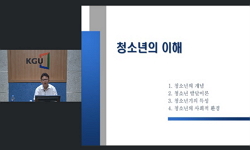Objectives:The objective of this study was to identify the risky behavior subtypes in adolescents with depression, and the relationship between those subtypes and suicide attempt. Methods:Ninety adolescents who met the Diagnostic and Statistica...
http://chineseinput.net/에서 pinyin(병음)방식으로 중국어를 변환할 수 있습니다.
변환된 중국어를 복사하여 사용하시면 됩니다.
- 中文 을 입력하시려면 zhongwen을 입력하시고 space를누르시면됩니다.
- 北京 을 입력하시려면 beijing을 입력하시고 space를 누르시면 됩니다.
https://www.riss.kr/link?id=A101087850
- 저자
- 발행기관
- 학술지명
- 권호사항
-
발행연도
2015
-
작성언어
Korean
-
주제어
Adolescent ; Depression ; Risky Behavior ; Suicide Attempt ; 청소년 ; 우울증 ; 위험행동 ; 자살시도
-
KDC
516
-
등재정보
KCI등재,SCOPUS,ESCI
-
자료형태
학술저널
-
수록면
149-158(10쪽)
-
KCI 피인용횟수
3
- 제공처
-
0
상세조회 -
0
다운로드
부가정보
다국어 초록 (Multilingual Abstract)
Objectives:The objective of this study was to identify the risky behavior subtypes in adolescents with depression, and the relationship between those subtypes and suicide attempt.
Methods:Ninety adolescents who met the Diagnostic and Statistical Manual of Mental Disorders-4th edition criteria for major depressive disorder, dysthymia, or depressive disorder not otherwise specified participated in the study. Participants were interviewed about suicidal attempts, non-suicidal self-injuries. Smoking, drinking behaviors, and searching for the word “suicide” on the internet, negative life events including bulling-bullied experiences, and history of abuse were also included with questionnaires.
Results:The results of cluster analysis showed that four risky behaviors were divided into three clusters : non-risky type, characterized by few risky behaviors ; delinquency type, which was characterized by smoking and drinking ; non-suicidal selfinjury type. In non-suicidal self-injury type, percentage of girls was higher and clinical symptoms were more severe than delinquency type. In addition, delinquency type members could be a bully, while non-suicidal self-injury type members could be abused by a family member. Logistic regression analysis showed that both risky behavior subtypes were significant predictors of suicide attempt.
Conclusion:These results suggest that two types of risky behaviors of depressed adolescents have an effect on the suicide attempts independently. Then, the implications and limitations of the study were discussed and directions for future studies were suggested.
참고문헌 (Reference)
1 이상구, "남녀 중 · 고등학생의 자살시도 예측요인" 한국간호과학회 41 (41): 652-662, 2011
2 Reynolds CR, "What I Think and Feel: a revised measure of Children’s Manifest Anxiety" 25 : 15-20, 1997
3 Gibbons RD, "The relationship between antidepressant medication use and rate of suicide" 62 : 165-172, 2005
4 Chae HJ., "The parents, children and professional’s perception on the concept of child abuse" Sookmyung Women’s Univ 1993
5 Joiner TE, "The interpersonal psychological theory of suicidal behavior indicates specific and crucial psychotherapeutic targets" 1 : 80-89, 2008
6 Kwon JY, "The effects of physical abuse to the emotions and behaviors in children" 3 : 73-83, 1992
7 Park MR., "The effects of emotional abuse by mother on children’s self-efficacy and tendency of interpersonal relations" Sookmyung Women’s Univ 2002
8 Bossarte RM, "The associations between early alcohol use and suicide attempts among adolescents with a history of major depression" 36 : 532-535, 2011
9 Posner K, "The Columbia-Suicide Severity Rating Scale: initial validity and internal consistency findings from three multisite studies with adolescents and adults" 168 : 1266-1277, 2011
10 Jung WC., "Suicide rate in adolescents have increased of 57.2%" Korean Data News
1 이상구, "남녀 중 · 고등학생의 자살시도 예측요인" 한국간호과학회 41 (41): 652-662, 2011
2 Reynolds CR, "What I Think and Feel: a revised measure of Children’s Manifest Anxiety" 25 : 15-20, 1997
3 Gibbons RD, "The relationship between antidepressant medication use and rate of suicide" 62 : 165-172, 2005
4 Chae HJ., "The parents, children and professional’s perception on the concept of child abuse" Sookmyung Women’s Univ 1993
5 Joiner TE, "The interpersonal psychological theory of suicidal behavior indicates specific and crucial psychotherapeutic targets" 1 : 80-89, 2008
6 Kwon JY, "The effects of physical abuse to the emotions and behaviors in children" 3 : 73-83, 1992
7 Park MR., "The effects of emotional abuse by mother on children’s self-efficacy and tendency of interpersonal relations" Sookmyung Women’s Univ 2002
8 Bossarte RM, "The associations between early alcohol use and suicide attempts among adolescents with a history of major depression" 36 : 532-535, 2011
9 Posner K, "The Columbia-Suicide Severity Rating Scale: initial validity and internal consistency findings from three multisite studies with adolescents and adults" 168 : 1266-1277, 2011
10 Jung WC., "Suicide rate in adolescents have increased of 57.2%" Korean Data News
11 Shaffer D., "Suicide in childhood and early adolescence" 15 : 275-291, 1974
12 Koh SH., "Studies on defining child abuse in Korea and the perceptual differences between mother and child toward the child abuse" Seoul National Univ 1992
13 Nrugham L, "Specific depressive symptoms and disorders as associates and predictors of suicidal acts across adolescence" 111 : 83-93, 2008
14 Lee CJ, "Self-concept and social support according to bullying types" 13 : 65-80, 2000
15 Callaghan S, "Self-concept and peer victimization among school children" 18 : 161-163, 1995
16 Muehlenkamp JJ, "Risk for suicide attempts among adolescents who engage in non-suicidal self-injury" 11 : 69-82, 2007
17 Bukstein OG, "Risk factors for completed suicide among adolescents with a lifetime history of substance abuse: a case-control study" 88 : 403-408, 1993
18 Neary A, "Pear victimization and its relationship to selfconcept and depression among school children" 16 : 183-186, 1994
19 Korea Centers for Disease Control and Prevention, "National Adolescent Health Behavior Survey" KCDC
20 Straus MA., "Measuring intra-family conflict and violence: the conflict tactics scale" 36 : 13-29, 1979
21 Kaufman L, "Finding groups in data: an introduction to cluster analysis" Wiley 1990
22 Rah HJ., "Factors influencing the impulse of suicide in adolescence" Konkuk Univ 2006
23 Harris KM, "Examining suicide-risk individuals who go online for suicide-related purposes" 13 : 264-276, 2009
24 Kingsbury S, "Do adolescents who take overdoses have specific psychological characteristics? A comparative study with psychiatric and community controls" 38 : 1125-1131, 1999
25 Tuisku V, "Depressed adolescents as young adults - predictors of suicide attempt and non-suicidal self-injury during an 8-year follow-up" 152-154 : 313-319, 2014
26 Renaud J, "Current psychiatric morbidity, aggression/impulsivity, and personality dimensions in child and adolescent suicide: a case-control study" 105 : 221-228, 2008
27 Nock MK, "Contextual features and behavioral functions of self-mutilation among adolescents" 114 : 140-146, 2005
28 Sankey M, "Brief report: classification of adolescent suicide and risk-taking deaths" 28 : 781-785, 2005
29 Choi JS, "Assessment of anxiety in children: reliability and validity of Revised Children’s Manifest Anxiety Scale" 29 : 691-702, 1990
30 Nasser EH, "Assessing varying degrees of lethality in depressed adolescent suicide attempters" 99 : 423-431, 1999
31 Statistics Korea, "Annual report on the cause of death statistics;2001-2013" Statistics Korea
32 Bridge JA, "Adolescent suicide and suicidal behavior" 47 : 372-394, 2006
동일학술지(권/호) 다른 논문
-
유산소 운동이 소아 및 청소년의 인지기능에 미치는 영향 : 문헌고찰
- 대한소아청소년정신의학회
- 강경두(Kyoung Doo Kang)
- 2015
- KCI등재,SCOPUS,ESCI
-
주의력결핍 과잉행동장애와 스마트폰 중독, 우울, 불안, 자존감
- 대한소아청소년정신의학회
- 이효철(Hyo Chul Lee)
- 2015
- KCI등재,SCOPUS,ESCI
-
지난 10년간 일 대학병원 정신건강의학과 소아청소년 초진환자 분포의 변화
- 대한소아청소년정신의학회
- 김효진(Hyo-Jin Kim)
- 2015
- KCI등재,SCOPUS,ESCI
-
아동청소년 성폭력 피해자의 피해사실 폭로에 영향을 미치는 요인
- 대한소아청소년정신의학회
- 한정수(Jung-Soo Han)
- 2015
- KCI등재,SCOPUS,ESCI
분석정보
인용정보 인용지수 설명보기
학술지 이력
| 연월일 | 이력구분 | 이력상세 | 등재구분 |
|---|---|---|---|
| 2022 | 평가예정 | 재인증평가 신청대상 (재인증) | |
| 2019-01-01 | 평가 | 등재학술지 유지 (계속평가) |  |
| 2016-01-01 | 평가 | 등재학술지 유지 (계속평가) |  |
| 2012-01-01 | 평가 | 등재 1차 FAIL (등재유지) |  |
| 2009-01-01 | 평가 | 등재학술지 선정 (등재후보2차) |  |
| 2008-01-01 | 평가 | 등재후보 1차 PASS (등재후보1차) |  |
| 2006-01-01 | 평가 | 등재후보학술지 선정 (신규평가) |  |
학술지 인용정보
| 기준연도 | WOS-KCI 통합IF(2년) | KCIF(2년) | KCIF(3년) |
|---|---|---|---|
| 2016 | 0.63 | 0.63 | 0.68 |
| KCIF(4년) | KCIF(5년) | 중심성지수(3년) | 즉시성지수 |
| 0.69 | 0.71 | 1.282 | 0.04 |






 ScienceON
ScienceON DBpia
DBpia






